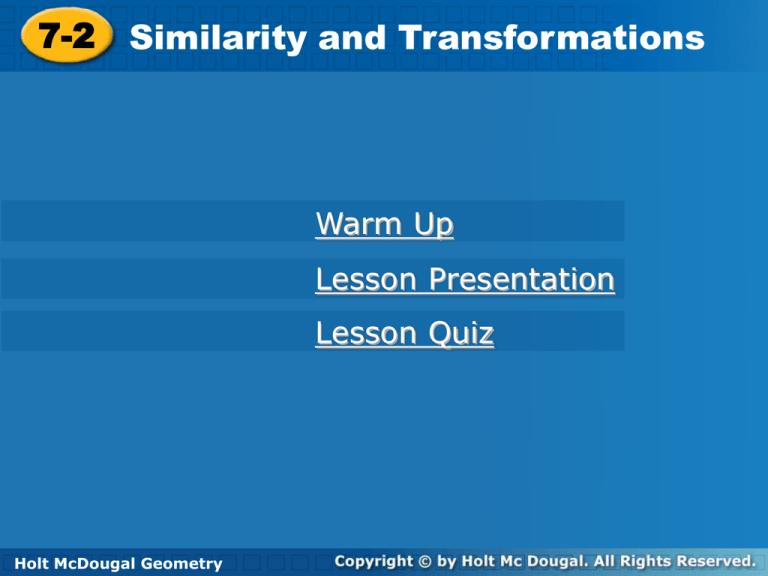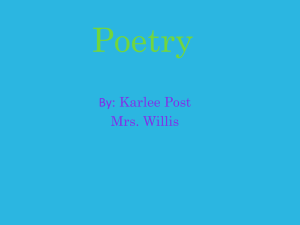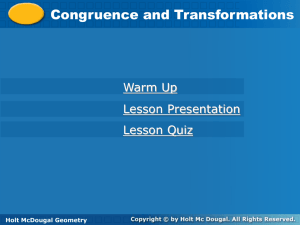Holt McDougal Geometry 7-2
advertisement

Similarity and and Transformations Transformations 7-2 7-2 Similarity Warm Up Lesson Presentation Lesson Quiz Holt HoltGeometry McDougal Geometry 7-2 Similarity and Transformations Warm Up Find the image point when the indicated transformation is applied to the given pre-image point. 1. (x, y) → (x + 3, y – 1); (2, 4) (5, 3) 2. (x, y) → (x, –y); (–2, 1) (-2,-1) 3. (x, y) → (3x, 3y); (–5, 0) (-15, 0) 4. (x, y) → 1 x, 1 y ; (3, -6) 3 3 (1,-2) Holt McDougal Geometry 7-2 Similarity and Transformations Objectives Draw and describe similarity transformations in the coordinate plane. Use properties of similarity transformations to determine whether polygons are similar and to prove circles similar. Holt McDougal Geometry 7-2 Similarity and Transformations Vocabulary similarity transformation Holt McDougal Geometry 7-2 Similarity and Transformations A transformation that produces similar figures is a similarity transformation. A similarity transformation is a dilation or a composite of one or more dilations and one or more congruence transformations. Two figures are similar if and only if there is a similarity transformation that maps one figure to the other figure. Holt McDougal Geometry 7-2 Similarity and Transformations Remember! Translations, reflections, and rotations are congruence transformations. Holt McDougal Geometry 7-2 Similarity and Transformations Example 1: Drawing and Describing Dilations A. Apply the dilation D to the polygon with the given vertices. Describe the dilation. D: (x, y) → (3x, 3y) A(1, 1), B(3, 1), C(3, 2) dilation with center (0, 0) and scale factor 3 Holt McDougal Geometry 7-2 Similarity and Transformations Example 1: Continued B. Apply the dilation D to the polygon with the given vertices. Describe the dilation. D: (x, y) → 3 x, 3 y 4 4 P(–8, 4), Q(–4, 8), R(4, 4) dilation with center (0, 0) and scale factor 3 4 Holt McDougal Geometry 7-2 Similarity and Transformations Check It Out! Example 1 Apply the dilation D : (x, y)→ 1 x, 1 y to the 4 4 polygon with vertices D(-8, 0), E(-8, -4), and F(4, -8). Name the coordinates of the image points. Describe the dilation. D'(-2, 0), E'(-2, -1), F'(-1, -2); dilation with center 1 (0, 0) and scale factor 4 Holt McDougal Geometry 7-2 Similarity and Transformations Example 2 : Determining Whether Polygons are Similar Determine whether the polygons with the given vertices are similar. A. A(–6, -6), B(-6, 3), C(3, 3), D(3, -6) and H(-2, -2), J(-2, 1), K(1, 1), L(1, -2) Yes; ABCD maps to HJKL by a dilation: 1x,1y (x, y) → 3 3 Holt McDougal Geometry 7-2 Similarity and Transformations Example 2: Continued B. P(2, 0), Q(2, 4), R(4, 4), S(4, 0) and W(5, 0), X(5, 10), Y(8, 10), Z(8, 0). No; (x, y) → (2.5x, 2.5y) maps P to W, but not S to Z. Holt McDougal Geometry 7-2 Similarity and Transformations Example 2: Continued C. A(1, 2), B(2, 2), C(1, 4) and D(4, -6), E(6, -6), F(4, -2) Yes; ABC maps to A’B’C’ by a translation: (x, y) → (x + 1, y - 5). Then A’B’C’ maps to DEF by a dilation: (x, y) → (2x, 2y). Holt McDougal Geometry 7-2 Similarity and Transformations Example 2: Continued D. F(3, 3), G(3, 6), H(9, 3), J(9, –3) and S(–1, 1), T(–1, 2), U(–3, 1), V(–3, –1). Yes; FGHJ maps to F’G’H’J’ by a reflection : (x, y) → (-x, y). Then F’G’H’J’ maps to STUV by a dilation: (x, y) 1 x , 1 y 3 3 Holt McDougal Geometry 7-2 Similarity and Transformations Check It Out! Example 2 Determine whether the polygons with the given vertices are similar : A(2, -1), B(3, -1), C(3, -4) and P(3, 6), Q(3, 9), R(12, 9). The triangles are similar because ABC can be mapped to A'B'C' by a rotation: (x, y) → (-y, x), and then A'B'C' can be mapped to PQR by a dilation: (x, y) → (3x, 3y). Holt McDougal Geometry 7-2 Similarity and Transformations Example 3: Proving Circles Similar A. Prove that Circle A with center (0, 0) and radius 1 is similar to circle B with center (0, 6) and radius 3. Holt McDougal Geometry 7-2 Similarity and Transformations Example 3: Continued Circle A can be mapped to circle A’ by a translation: (x, y) → (x, y + 6). Circle A’ and circle B both have center (0, 6). Then circle A’ can be mapped to circle B by a dilation with center (0, 6) and scale factor 3. So circle A and circle B are similar. B. Prove that Circle C with center (0, –3) and radius 2 is similar to circle D with center (5, 1) and radius 5. Holt McDougal Geometry 7-2 Similarity and Transformations Example 3: Continued Circle C can be mapped to circle C’ by a translation: (x, y) → (x + 5, y + 4). Circle C’ and circle D both have center (5, 1).Then circle C’ can be mapped to circle D by a dilation with center (5, 1) and scale factor 2.5. So circle C and circle D are similar. Holt McDougal Geometry 7-2 Similarity and Transformations Lesson Quiz : Part-I 1. Apply the dilation D: (x, y) to the polygon with vertices A(2, 4), B(2, 6), and C(6, 4). Name the coordinates of the image points. Describe the dilation. A’(3, 6), B’(3, 9), C’(9, 6); dilation with center 3 (0, 0) and scale factor 2 Holt McDougal Geometry 7-2 Similarity and Transformations Lesson Quiz : Part-II Determine whether the polygons with the given vertices are similar. 2. A(-4, 4), B(6, 4), C(6, -4), D(-4, -4) and P(-2, 2), Q(4, 2), R(4, -2), S(-2, -2) No; (x, y) → (0.5x, 0.5y) maps A to P, but not B to Q. 3. A(2, 2), B(2, 4), C(6, 4) and D(3, -3), E(3, -6), F(9, -6) Yes; △ ABC maps to △ A’B’C’ by a reflection: (x, y) → (x, -y). Then △ A’B’C’ maps to △DEF by a dilation:(x, y) → (1.5x, 1.5y). Holt McDougal Geometry










